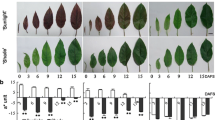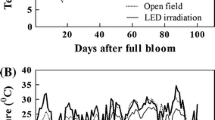Abstract
To evaluate the effects of different partial shading treatments on the synthesis of anthocyanins under UV-A irradiation in soybean sprouts, we examined the anthocyanin content, transcript levels of key genes related to anthocyanin biosynthesis (CRY1, CRY2, PAL, CHS, CHI, DFR, ANS and UFGT), and the activity of phenylalanine ammonia-lyase (PAL). The results showed that UV-A radiation could significantly increase the content of anthocyanins in the epidermal layer of hypocotyls in soybean sprouts. This trend was consistent with the pattern of anthocyanin biosynthesis-related gene expressions, which were significantly up-regulated by UV-A. Different partial shading treatments significantly reduced the content of anthocyanins and the expression of DFR, ANS, and UFGT in response to the UV-A irradiation. Cotyledon-shading treatment lowered the content of anthocyanin due to the down-regulation of the expression of anthocyanin biosynthesis-related genes, but this effect is limited. Compared with the cotyledon and the upper part of hypocotyls, the lower part of hypocotyls was the predominant site of anthocyanin synthesis in soybean sprouts. These findings imply that anthocyanins in hypocotyls are biosynthesised locally, and there is no systemic biosynthesis, which was further supported by the PAL activity and the transcripts of the genes responsible for anthocyanin biosynthesis.







Similar content being viewed by others
References
Albert N, Davies K, Lewis D, Zhang H, Montefiori M, Brendolise C, Boase M, Ngo H, Jameson P, Schwinn K (2014) A conserved network of transcriptional activators and repressors regulates anthocyanin pigmentation in eudicots. Plant Cell 26:962–980
Brouwer B, Gardestrom P, Keech O (2014) In response to partial plant shading, the lack of phytochrome A does not directly induce leaf senescence but alters the fine-tuning of chlorophyll biosynthesis. J Exp Bot 14:4037–4049
Buer SC, Muday KG, Diordjevic AM (2007) Flavonoids are differentially taken up and transported long distances in Arabidopsis. Plant Physiol 145:478–490
Cominelli E, Gusmaroli G, Allegra Galbiatia M, Wade HK, Jenkins G, Tonelli C (2008) Expression analysis of anthocyanin regulatory genes in response to different light qualities in Arabidopsis thaliana. J Plant Physiol 165:886–894
Das P, Shin D, Choi SB, Park YL (2012) Sugar-hormone cross-talk in anthocyanin biosynthesis. Mol Cells 34:501–507
Davies KM, Albert NW, Schwinn KE (2012) From landing lights to mimicry: the molecular regulation of flower colouration and mechanisms for pigmentation patterning. Funct Plant Biol 39:619–638
Dubos C (2012) MYB transcription factors in Arabidopsis. Trends Plant Sci 15(10):573–581
Feng FJ, Li MJ, Ma FW, Cheng LL (2014) The effects of bagging and debagging on external fruit quality, metabolites, and the expression of anthocyanin biosynthetic genes in ‘Jonagold’ apple (Malus domestica Borkh.). Sci Hortic 165:123–131
Gonzalez OD, Vondkin OL (2007) Specific elements of the glyoxylate pathway play a significant role in the functional transition of the soybean cotyledon during seedling development. BMC Genom 8:468
Gould KS (2004) Nature’s Swiss army knife: the diverse protective roles of anthocyanins in leaves. J Biomed Biotechnol 2004:314–320
Guo J, Wang MH (2010) Ultraviolet A-specific induction of anthocyanin biosynthesis and PAL expression in tomato (Solanum lycopersicum L.). Plant Growth Regul 62:1–8
He J, Giusti M (2010) Anthocyanins: natural colorants with health-promoting properties. Annu Rev Food Sci Technol 1:163–187
Huang J, Gu M, Lai Z, Fan B, Shi K, Zhou YH, Yu JQ, Chen Z (2010) Functional analysis of the Arabidopsis PAL gene family in plant growth, development, and response to environmental stress. Plant Physiol 153:1526–1538
Jenkins GI (2009) Signal transduction in responses to UV-B radiation. Annu Rev Plant Biol 60:407–431
Jeong SW, Das PK, Jeoung SC, Song JY, Lee HK, Kim YK, Kim WJ, Il Park Y, Yoo SD, Choi SB, Choi G, Park YI (2010) Ethylene suppression of sugar-induced anthocyanin pigmentation in Arabidopsis. Plant Physiol 154:1514–1531
Jiao YL, Lau OS, Deng XW (2007) Light-regulated transcriptional networks in higher plants. Nat Rev Genet 3(8):217–230
Jiao J, Gai QY, Wang W, Luo M, Gu CB, Fu YJ, Ma W (2015) Ultraviolet radiation-elicited enhancement of isoflavonoid accumulation, biosynthetic gene expression, and antioxidant activity in Astragalus membranaceus hairy root cultures. J Agric Food Chem 63:8216–8224
Kakuszi A, Boddi B (2014) Light piping activates chlorophyll biosynthesis in the under-soil hypocotyl section of bean seedlings. J Photochem Photobiol B 140:1–7
Kim HJ, Chen F, Wang X, Choi JH (2006) Effect of methyl jasmonate on phenolics, isothiocyanate, and metabolic enzymes in radish sprout (Raphanus sativus L.). J Agric Food Chem 54:7263–7269
Kim SL, Lee JE, Kwon YU, Kim WH, Jung GH, Kim DW, Lee CK, Lee YY, Kim MJ, Kim YH, Hwang TY, Chung IM (2013) Introduction and nutritional evaluation of germinated soy germ. Food Chem 136:491–500
Koes R, Verweij W, Quattrocchio F (2005) Flavonoids: a colorful model for the regulation and evolution of biochemical path ways. Trends Plant Sci 10(5):236–242
Koide T, Kamei H, Hashimoto Y (1996) Antitumor effect of hydrolyzed anthocyanin from grape rinds and red rice. Cancer Biother Radiopharm 11(4):273–277
Kubo H, Peeters AJM, Aarts MGM, Pereira A, Koornneef M (1999) ANTHOCYANINLESS2, a homeobox gene affecting anthocyanin distribution and root development in Arabidopsis. Plant Cell 7(11):1217–1226
Lee MJ, Son J, Oh MM (2014) Growth and phenolic compounds of Lactuca sativa L. grown in a closed-type plant production system with UV-A, -B, or -C lamp. J Sci Food Agric 94:197–204
Li YY, Mao K, Zhao C, Zhao XY, Zhang RF, Zhang HL, Shu HR, Hao YJ (2013) Molecular cloning and functional analysis of a blue light receptor gene MdCRY2 from apple (Malus domestica). Plant Cell Rep 4(32):555–566
Liu X, Cohen J, Gardner G (2011) Low-fluence red light increases the transport and biosynthesis of auxin. Plant Physiol 157:891–904
Loreti E, Povero G, Novi G, Solfanelli C, Alpi A, Perata P (2008) Gibberellins, jasmonate and abscisic acid modulate the sucrose-induced expression of anthocyanin biosynthetic genes in Arabidopsis. New Phytol 179:1004–1016
Maekawa M, Sato T, Kumagai T, Noda K (2001) Differential responses to UV-B irradiation of three near isogenic lines carrying different purple leaf genes for anthocyanin accumulation in rice (Oryza sativa L.). Breed Sci 51(1):27–32
Mendez M, Jones DG, Manetas Y (1999) Enhanced UV-B radiation under field conditions increases anthocyanin and reduces the risk of photoinhibition but does not affect growth in the carnivorous plant Pinguicula vulgaris. New Phytol 144(2):275–282
Moglich A, Yang XJ, Ayers RA, Moffat K (2010) Structure and function of plant photoreceptors. Annu Rev Plant Biol 61:21–47
Mostafa MM, Rahma EH (1987) Chemical and nutritional changes in soybean during germination. Food Chem 23(4):257–275
Preuten T, Hohm T, Bergmann S, Fankhauser C (2013) Defining the site of light perception and initiation of phototropism in Arabidopsis. Curr Biol 19(23):1934–1938
Shabala S, White GR, Djordjevic AM, Ruan YL, Mathesius U (2016) Root-to-shoot signaling: integration of diverse molecules, pathways and functions. Funct Plant Biol 43:87–104
Su NN, Wu Q, Liu YY, Cai JT, Shen WB, Xia K, Cui J (2014) Hydrogen-rich water reestablishes ROS homeostasis but exerts differential effects on anthocyanin synthesis in two varieties of radish sprouts under UV-A irradiation. J Agric Food Chem 62(27):6454–6462
Tanaka Y, Sasaki N, Ohmiya A (2008) Biosynthesis of plant pigments: anthocyanins, betalains and carotenoids. Plant J 54:733–749
Tossi V, Lombardo C, Cassia R, Lamattina L (2012) Nitric oxide and flavonoids are systemically induced by UV-B in maize leaves. Plant Sci 193–194:103–109
Tsurunaga Y, Takahashi T, Katsube T, Kudo A, Kuramitsu O, Ishiwata M, Matsumoto S (2013) Effects of UV-B irradiation on the levels of anthocyanin, rutin and radical scavenging activity of buckwheat sprouts. Food Chem 141(1):552–556
Tumova L, Tuma J (2011) The effect of UV light on isoflavonoid production in Genista tinctoria culture in vitro. Acta Physiol Plant 33:635–640
Wang H, Nair MG, Strasburg GM, Chang YC, Booren AM, Gray JI, DeWitt DL (1999) Antioxidant and anti-inflammatory activities of anthocyanins and their ahlycon, cyaniding, from tart cherries. J Nat Prod 62(2):294–296
Wang Y, Zhou B, Sun M, Li Y, Kawabata S (2012) UV-A light induces anthocyanin biosynthesis in a manner distinct from synergistic blue + UV-B light and UV-A/blue light responses in different parts of the hypocotyls in turnip seedlings. Plant Cell Physiol 53(8):1470–1480
Wang L, Albert NW, Zhang HB, Arathoon S, Boase MR, Ngo H, Schwinn KE, Davies KM, Lewis DH (2014) Temporal and spatial regulation of anthocyanin biosynthesis provide diverse flower colour intensities and patterning in Cymbidium orchid. Planta 5(240):983–1002
Yuan YX, Chiu LW, Li L (2009) Transcriptional regulation of anthocyanin biosynthesis in red cabbage. Planta 6:1141–1153
Zhang ZZ, Li XX, Chu YN, Zhang MX, Wen YQ, Duan CQ, Pan QH (2012) Three types of ultraviolet irradiation differentially promote expression of shikimate pathway genes and production of anthocyanins in grape berries. Plant Physiol Bioch 57:74–83
Zhou B, Li Y, Xu Z, Yan H, Homma S, Kawabata S (2007) Ultraviolet A-specific induction of anthocyanin biosynthesis in the swollen hypocotyls of turnip (Brassica rapa). J Exp Bot 58:1771–1781
Zhou B, Wang Y, Zhan Y, Li Y, Kawabata S (2013) Chalcone synthase family genes have redundant roles in anthocyanin biosynthesis and response to blue/UV-A light in turnip. Am J Bot 100(12):2458–2467
Acknowledgments
This work was supported by the National Natural Science Foundation of China (31572169) and Jiangsu Agriculture Science Technology Innovation Fund (CX(15)1040).
Author information
Authors and Affiliations
Corresponding author
Electronic supplementary material
Below is the link to the electronic supplementary material.
344_2016_9617_MOESM1_ESM.tif
Supplementary material 1 (TIFF 7920 kb) The concentration of soluble sugar in the hypocotyls of soybean sprouts under UV-A irradiation at 12, 24 and 36 h. Con, untreated under UV-A; RC, remove the cotyledons under UV-A; CC, cover the cotyledons under UV-A. Plants were grown in the dark for 60 h and then were removed or covered the cotyledons and transferred to 5 W m−2 UV-A light for another 12, 24 or 36 h to harvest. The concentration of soluble sugar was measured by spectrophotometric method. Dates are the mean ± standard error (n = 3); Different letters are significantly different at level P < 0.05
Rights and permissions
About this article
Cite this article
Su, N., Wu, Q., Qi, N. et al. Effect of Partial Shading Treatments on Anthocyanin Synthesis in the Hypocotyls of Soybean Sprouts Under UV-A irradiation. J Plant Growth Regul 36, 50–59 (2017). https://doi.org/10.1007/s00344-016-9617-y
Received:
Accepted:
Published:
Issue Date:
DOI: https://doi.org/10.1007/s00344-016-9617-y




